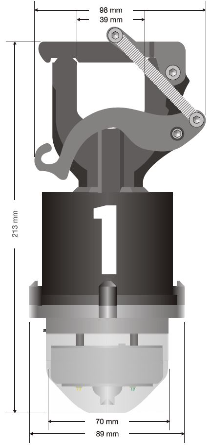FLA4VL - For MV Overhead Networks
The fault indicator type FLA4 is designed to be used on overhead lines of a medium voltage network. The type FLA4 can detect faults with two methods. The short-circuit detection method monitors the network current with a fixed threshold and a response delay filter. The fixed threshold can be manually adjusted or automatically calculated on basis of the current load and an adjustable factor.
The earth-fault detection method monitors the deviation of the current load within a certain amount of time with a di/dt algorithm. If the increase of the load current exceeds an adjustable current value, the voltage status of the network is monitored. In case of a voltage loss a fault is detected.
Configuration by remote control
All settings of the indicator can be adjusted very flexibly with the help of a remote control. In this way, the configuration of the device can be adjusted at any time without removing the indicator from the network.
The bidirectional short-range radio communication between indicator and remote control also allows to read out the configuration of the indicator, temperature values, the voltage status of the network and current measurements from the network.
Installation and indication
The indicator can be mounted under live conditions with the help of an adapter and a hot stick. The indication of faults is performed by an ultra bright flashing LED with focussing lens for optimised light distribution for enhanced visibility in the distance.
SCADA integration
The fault indicator type FLA4 can be connected to the remote indication interface type RIS via the integrated short-range radio module. This allows an easy-to-install and retrofittable integration of the overhead line indicators into remote monitoring systems
FEATURES & OPTIONS
| Fault detection by threshold |
Manually adjustable trip current with adjustable response delay filter |
| Automatic mode |
Trip current can be calculated with a factor on basis of the current load with adjustable upper limit |
| di/dt fault detection |
Faults detection on basis of current load deviation with subsequent voltage loss |
| Temporary fault detection |
Detects situations when the network recovers after fault detection, eg; by automatic reclosing of the network |
| Inrush current detection |
Overcurrents are filtered up to 5sec after network energisation |
| Current-on filter |
This filter helps to filter out high currents which trigger the indicator but do not shut down the network |
| Enhanced power supply |
Internal super-capacitors are charged by the network current. The device is self-sustained from a network current load of 4A upwards.
As fallback there are lithium batteries for operation in longer downtimes |
| Full wireless configuration |
All settings can be changed and read-out with the handheld remote type HS control or by the remote indication interface type RIS-FS. |
| Live data read-out |
Current load, voltage status and temperature read-outs can be wirelessly read-out by remote control or remote indication interface. |
| Internal log |
Up to 100 log entries for events and configuration changes |
| Voltage detection |
Two threshold levels can be selected for a better detection of the voltage status
- voltage off level: percentage of Un when the voltage is considered as off
- voltage on level: percentage of Un when the voltage is considered as on |
| Remote indication |
Faults, resets and voltage or current status changes can be remotely indicated. |
| Remote data-logging |
Regular remote transmissions for data read-outs of current loads, voltage status and internal temperature are configurable in short intervals.
(Please see the data sheet of the remote indication interface type RIS-FS for more information.) |
DIMENSIONS

DATASHEET
.jpg)